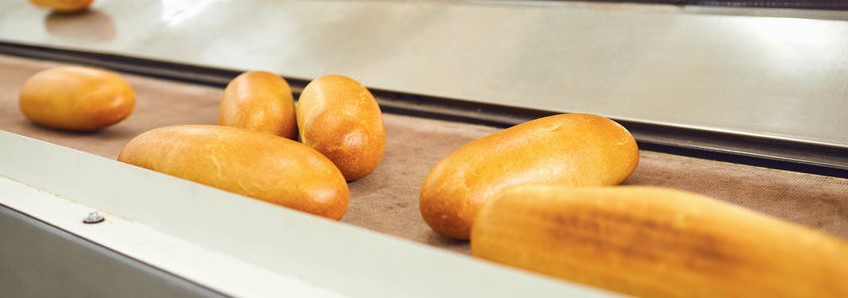
The cooling process allows the bread loaf to reach optimum slicing temperature and achieve moisture equilibration between the crumb and the crust. However, sealing in visible moisture condensation on the packaging is not a desirable way to ship product. Thermal profiling data is the solution for validating optimum cooling lines performance in the bakery.
Purposes of cooling
Cooling is necessary for a variety of reasons. One of the top ones is to decrease the internal temperature of the baked bread from about 200°F (93°C), at normal atmospheric conditions, to 86–104°F (30–40°C).
Secondly, cooling creates moisture equilibrium between the crumb and crust. As the loaf cools, some of the moisture moves toward the crust and the crust becomes softer and rubbery—not the hard shell that emerged from the oven. If managed property, moisture migration results in a less brittle or friable crust at the slicer.
The science behind the cooling process
Just like baking or freezing, cooling of baked goods involves simultaneous heat and mass transfer processes.
Heat transfer takes place thanks to the difference in temperatures between the product’s core (at higher temperature) and cooling environment (at lower temperature). This causes the product to lose heat to the surroundings. The temperature gradient is at its maximum at the end of baking and beginning of cooling, but decreases to reach zero with progressive cooling.
Simultaneously, baked bread loses some of its moisture and dries out due to water migration. Water migration occurs thanks to a difference in water content between the crumb (at higher moisture) and crust (at lower moisture) which is exposed to convective air drafts.
Molecularly, cooling causes the amylose fraction of starch to retrograde, i.e. to re-crystallize almost completely in order to set the somewhat firm crumb texture. This transition is key and makes possible the bread slicing operation without collapsing the product under the cutter’s mechanical pressures.
What defines optimum cooling lines?
An optimum cooling operation is the one that takes the minimum amount of time and energy, while achieving the required temperature decrease and minimizing product loss.
Typical cooling times for white pan bread in high-speed spiral coolers which use air drafts are 45–70 minutes. Denser breads, such as artisan, hearth, multigrain and variety breads, may require more time. About 2–3% of moisture is lost, called cooling loss. So, completing the cooling process as quickly as possible is important.
Over-cooling means that the product is too cool and an excessive amount of water has been lost during cooling.
Here are some consequences of over-cooling:
- A higher cooling loss has taken place (this could force bakery management to increase scaling weight at the divider to meet declared weight on label). Adding extra grams to each dough piece really hurts batch yield and negatively impacts baker’s financial health
- The finished product will be drier and firmer with brittle, harsh eating qualities
- The dryness and loss of moisture will contribute to the loaf staling faster as water helps to reduce staling rate
- Excessive slicing loss as more bread crumbs are produced at the slicers (more waste is hence created)
On the other hand, an under-cooling scenario means that the product’s crumb is too warm and too moist because not enough heat and water have been reduced during cooling.
Here are some consequences of under-cooling:
- Loaf sidewalls will be weak and may collapse while passing through the slicer
- Slices will be ragged and may tear due to excessive moisture remaining in the loaf and the crumb being too soft
- The blades of the slicer may collect excessive build-up due to the high moistness of the crumb
- Excess moisture encourages mold growth
Seasonal effect on bread cooling
It is important to keep in mind that ambient temperature and changes in seasons impact the cooling step and how fast it proceeds. This is essential in commercial bakeries that do not have dedicated HVAC systems for cooling air, and instead have spiral cooler installations which rely on fresh air being injected from the facility’s exterior.
During winter, cooling times may be shorter as fresh air contains less water vapor per Kg or dry air. Low humidity conditions common during winter can cause checking and cracking of the crust. A relative humidity of 75–85% could be ideal for the wrapping room.
During hot and humid summers, cooling times may be longer, and fans may be used to speed up the process.
How can we monitor and control the cooling process?
Just as any other heat transfer operation, the cooling process can be profiled with the same tools used for profiling baking or proofing steps. The M.O.L.E.® thermal profiler can be used to record batch (cooling racks) as well as continuous (conveyorized) cooling processes.
In case of using the same data recorder to profile both the oven and cooler, of course depanning occurs between those two steps. So, both processes should be treated as separate thermal profiles. Therefore, it is best practice to retrieve the thermal profiler and sensors as it emerges from the batch or conveyorized oven as normal, treating cooling lines profiling as a separate task.
By looking at the temperature curve as the product is cooled, bakery managers can see how fast or slow cooling takes place at crumb level, as well as visualizing the behavior of ambient air temperature throughout the cooling process. This is critical for vacuum cooling operations which heavily rely on evaporative cooling as the unique driving force for product cooling. Placing a combination of dough and ambient sensors accomplishes this in either case.
In summary, the key for an optimum baking and cooling step is to achieve the proper processing rate that minimizes weight loss and yet allows the product to reach optimum quality characteristics. Thermal profiling data is the solution for validating optimum cooling lines performance.

